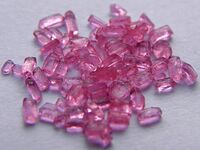Chemistry:Neodymium(III) sulfate
 Neodymium sulfate crystals
| |
| Names | |
|---|---|
| IUPAC name
Neodymium(III) trisulfate
| |
Other names
| |
| Identifiers | |
3D model (JSmol)
|
|
| ChemSpider | |
| EC Number |
|
PubChem CID
|
|
| UNII | |
| |
| |
| Properties | |
| Nd2(SO4)3 | |
| Molar mass | 576.7 g/mol |
| Appearance | Pink crystals |
| Density | 2.85 g/cm3 |
| Melting point | 700 °C (1,292 °F; 973 K) |
| 8 g/100 ml (20 °C) | |
| Solubility | Soluble in sulfuric acid |
| Structure[2] | |
| Monoclinic | |
| C2/c | |
a = 13.76 Å, b = 7.20 Å, c = 18.65 Å
| |
| Explosive data | |
| Shock sensitivity | Not explosive |
| Friction sensitivity | Not explosive |
| Hazards | |
| Main hazards | Irritant |
| GHS pictograms | 
|
| H315, H319, H335 | |
| P261, P280, P304, P340, P305+351+338, P405, P501 | |
| NFPA 704 (fire diamond) | |
| Flash point | Not flammable |
| Not flammable | |
| Related compounds | |
Other anions
|
Neodymium nitrate |
Other cations
|
Praseodymium(III) sulfate |
Related compounds
|
Neodymium sulfate octahydrate |
Except where otherwise noted, data are given for materials in their standard state (at 25 °C [77 °F], 100 kPa). | |
| Infobox references | |
Neodymium(III) sulfate is a salt of the rare-earth metal neodymium that has the formula Nd2(SO4)3. It forms multiple hydrates, the octa-, penta-, and the dihydrate, which the octahydrate is the most common. This compound has a retrograde solubility, unlike other compounds, its solubility decreases with increasing temperature.[3] This compound is used in glass for extremely powerful lasers.
Preparation
Neodymium sulfate is produced by dissolving neodymium(III) oxide in sulfuric acid:
- Nd
2O
3 + 3H
2SO
4 → Nd
2(SO
4)
3 + 3H
2O
It can also be prepared by the reaction of neodymium(III) perchlorate and sodium sulfate.
Properties
Neodymium sulfate octahydrate decomposes at 40 °C to the pentahydrate, which in turn decomposes to the dihydrate at 145 °C. The dihydrate dehydrates to the anhydrous form at 290 °C.[4]
References
- ↑ "Neodymium Sulfate | 13477-91-3". https://www.chemicalbook.com/ChemicalProductProperty_EN_CB1705313.htm.
- ↑ Donald R. Fitzwater; R. E. Rundle (1952) (in en). Structure of Neodymium Sulfate Octahydrate. University of Minnesota: Ames Laboratory, Iowa State College. https://books.google.com/books?id=t0BIAQAAMAAJ.
- ↑ Art. A. Migdisov; V. V. Reukov; A. E. Williams-Jones (2005). "A spectrophotometric study of neodymium(III) complexation in sulfate solutions at elevated temperatures" (in en). Geochimica et Cosmochimica Acta 70 (4): 983–992. doi:10.1016/j.gca.2005.11.001.
- ↑ Wendlandt, W W (1958). "The thermal decomposition of yttrium and the rare earth metal sulphate hydrates" (in en). J. Inorg. & Nuclear Chem. 7 (1–2): 51–54. doi:10.1016/0022-1902(58)80026-3.
 |


